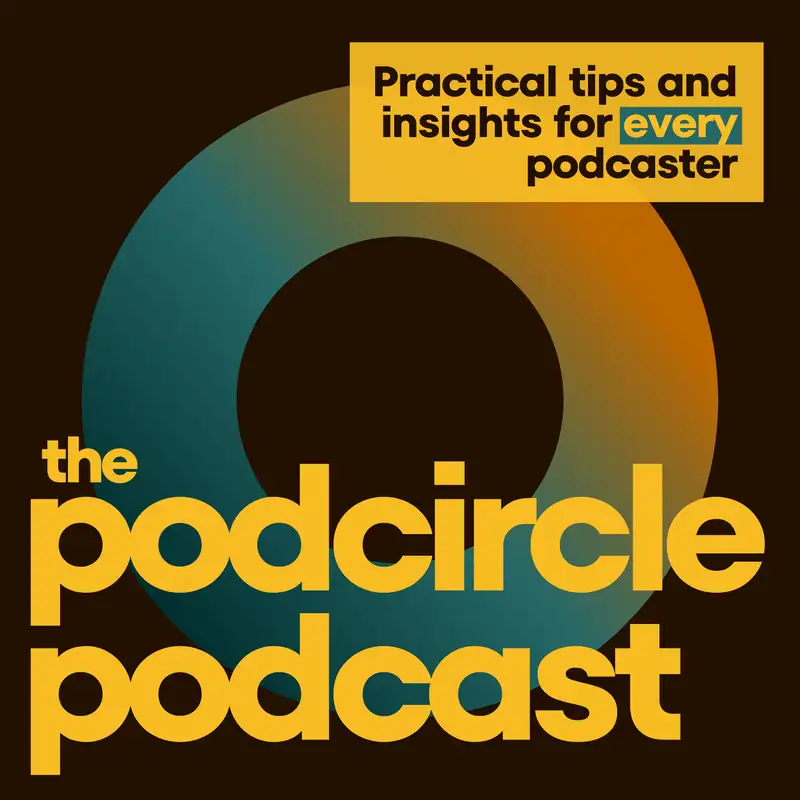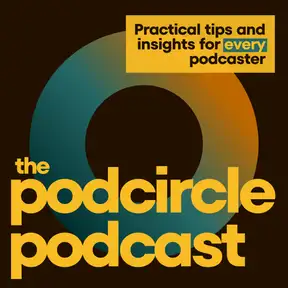16. What is Podcast Hosting (and which platform is right for you)?
So Libsyn, Buzzsprout is another one, Simplecast, Anchor, Megaphone, which is also owned by Spotify, another one called Omni, and then transistor dotfm, which if you've listened to this podcast for any amount of time, you'll know is one that we talk about and use almost exclusively, and we'll talk about the almost more as we dive in. Welcome to the Pod Circle podcast where we bring practical tips and insights for every podcaster.
Mickenzie Vought:Whether you're just getting started or you're already a seasoned podcast pro, these conversations dive into all the topics that matter most to you. Alright. Today, we're talking all about podcast hosting. What it is, what features to look for, and ultimately, which podcast hosting platform is going to be right for you. And we're gonna share the podcast hosting platform that we use for 99% of all PodCircle clients. So first, Kyle, what is podcast hosting? We're not just talking about being the host of a podcast. Right?
Kyle Cummings:So podcast hosting, simply put, a podcast hosting platform, it distributes all of your podcast content to listening apps like Apple Podcasts, Spotify, you name it. So this is what at a very base level, this is what all podcast hosting platforms do. And so I'm we're gonna talk about 7 of them, and we're really gonna do the deep dive in in the next episode. But today, we'll just kinda be an an overview. So some of those platforms that you've probably heard of are Libsyn, which they were the first to market back in 2004.
Mickenzie Vought:So they've been on the scene a long time.
Kyle Cummings:Yeah. They were the the very first. So they were actually founded about 6 months prior to Apple starting to support podcast in Itunes if you remember those early, early days.
Mickenzie Vought:Oh, I do. Yeah.
Kyle Cummings:So Libsyn, Buzzsprout is another one, Simplecast, Anchor, which is just recently been rebranded as Spotify for podcasters, and Megaphone, which is also owned by Spotify, another one called Omni, and then transistor.fm, which if you've listened to this podcast for any amount of time, you'll know is one that we talk about and use almost exclusively. And we'll talk about the almost more as we dive in. So like I said in our part 2 of this episode, we're gonna break down these 7 different platforms and give the key differences between them and tell you which one we use. Hint. It's Transistor. But and we're also gonna tell you exactly why.
Mickenzie Vought:Yeah. I feel like this is just gonna be an ad for Transistor, but it's strictly because we love it so much. And, honestly, you've used a lot of platforms. I've used a couple different hosting platforms, and I just continue to come back to, like, Transistor is the best bang for your buck. So we'll get there. We'll talk about it. We know kind of what a podcast hosting platform does. It gives it to all the people. It spreads it to all the different places that people can get their podcast. What are some of those differentiators that we're talking about that really set different ones apart or could help us identify which one would be best for us?
Kyle Cummings:So the first one is gonna be the user interface, which as someone who is, you know, managing a lot of podcasts for our clients, it's it's really important. So just a simple, feature, like, being able to drag and drop your MP3s.
Mickenzie Vought:So important.
Kyle Cummings:Yeah. It's really nice, so you don't have to go and dig through, you know, files and folders and things like that. And you'd be surprised how many podcast hosting apps still don't have a drag and drop feature. So to me, you know, as someone who I jokingly say, I I just sling files all over the Internet for a living, that ease of use and that functionality is really important. The second one is just that it's an intuitive user interface, that the functionality is really intuitive. So simply put, when you log in, does it make sense? Like, when you create a new episode or maybe you're starting a new podcast, it's something that I think that Transistor does. Lightyear is better than anyone, is even just helping you get your podcast channel started, and then your podcast episodes distributed, like, pointing them to all the different listening apps, like Apple and Spotify. That used to be a real headache, and Transistor has made that really streamlined and just really, really step by step. So, you know, are things laid out in a way that makes sense?
Kyle Cummings:That's that sort of stuff.
Mickenzie Vought:I remember when you helped me set up my very first podcast distribution on a host site. We were doing Libsyn, and it was so confusing. We were over Zoom, and you were showing me things, and you're like, I think this is the way we do it. It was it was complicated to figure out. I remember specifically around Apple.
Mickenzie Vought:And once you get it, you're like, once we get it, it'll be set forever.
Kyle Cummings:Yeah.
Mickenzie Vought:But we've gotta go through all of these steps.
Kyle Cummings:So Gotta go through the steps. Gotta create an Apple ID, you know, things like that. So it's there are some steps to getting that stuff set up. So the last one I'll I'll say here and then, again, one of the the things that I really love about Transistor is that they have little helpful explainer hotspots everywhere. So if you just mouse over, it'll tell you what this form is that, you know, they're just it's really helpful.
Kyle Cummings:And I've actually learned some things just about, like, you know, podcast subscriber numbers. They have a helpful little explainer and transistor that says that that podcast subscriber numbers are really difficult to count and to measure, and it kinda gives the reasons why. I've never heard it. I've never had a host explain that to me before. I just always wondered why.
Kyle Cummings:Like, why don't they give me my subscriber numbers? Well, it's it's actually really hard to tell that because they're pulling all this data from all these different listening apps because it's not just this one big thing. It's not it's not easy to tell. So
Mickenzie Vought:That's funny that you mentioned that because I was in our transistor. You recently helped on-site move over into transistor, and Yeah. I saw that same thing. And I was like, oh, that's super helpful having to report to stakeholders all the time, and they want that number. And I'm like, it I don't have it for you. And even just getting the language around that was was funny. So that's that's ironic that you mentioned that. What are some of the features that a hosting platform can provide outside of just distributing it to all the places that you need? What are the other things that you could look for in a podcast hosting platform?
Kyle Cummings:It's a great question. The biggest one in my opinion is something called dynamic ad insertion. If you're running ads on your podcast, this is the way of the future. This is the way it could and should be done. So we'll talk about that a bit more in-depth in the next episode of this podcast hosting series, but that is a big one. Another one is the ability to post your audio episodes to your YouTube channel. So Transistor, they have an integration with YouTube that allows you to do this. So if you're not quite ready to make the investment into starting a video podcast, this is a great, easy set it and forget it kind of way to get those audio episodes up on YouTube. All you really have to do is, you know, is sign in to your YouTube slash Google account via Transistor, and then just hop in Canva and create just a static image that is what's gonna be displayed while the podcast is playing. So
Mickenzie Vought:So it's like an optimized size for YouTube.
Kyle Cummings:Exactly. If you wanna go into your YouTube account after that and then swap out that thumbnail with something that's more customized for that episode, you can do that, which I would actually recommend you do. So another big one, especially if you're you're working with multiple people, is managed user access and roles. So
Mickenzie Vought:You use this a lot at PodCircle. Right?
Kyle Cummings:Definitely. Especially when I'm setting up or migrating people's accounts over to Transistor. Like you, like, I just Mackenzie cohosts a couple different podcasts for her organization. I just gave her right away, gave her admin access so so that she can do anything that I can do in the platform so that she can make any kind of adjustments needed. But it's nice too because you can also give kinda lower level access, just member access. And I think there's a level where you can just someone can just hop in and pull analytics. So I really like that kind of gated access just for security purposes. Some of these posting platforms also allow you to create a basic podcast website, which I think is really, really nice If you're not ready to go and have one designed for your website, maybe you don't have a website yet. They've got I know on transistor in particular, 4 different templates you can choose from, and you can customize the colors and things like that. It's just a really, really nice landing page for your podcast.
Mickenzie Vought:And that's what we use for Podcircle Podcast.
Kyle Cummings:It sure is. Yeah. At least for the time being. And then you can also so right now, our URL is, I think, it's podcirclepodcast.transistor.fm. But Yeah. They do have the ability to to do custom domain mapping. So say we want to redirect that to podcircle.com/podcast, and it's kind of more a part of our website. I really, really like the ability for folks to be able to do that. I think it's a really nice touch. Moving on is the ability to have private podcasting. This is actually the how I found Transistor. I was working with a really large company, and they wanted to produce a private podcast that's but they wanted it to be available on all the popular listening apps, but to be private, if that makes sense. So it's not searchable. Totally private. I loved the idea. I'd never heard of it. So I went searching. I found Transistor. They crush it. They do really, really well with this. So that's actually how I found Transistor.
Mickenzie Vought:So as opposed to saying, I'm just gonna give you a link to listen to this, and it's external. They can go where they're already getting their podcast and kinda just keep a user flow a lot easier.
Kyle Cummings:Yeah. It's actually they do have to subscribe. So it's a separate RSS feed. So Yes. Getting a little bit in the weeds here, like, just a normal podcast like this one, PodCircle podcast, is 1 RS fit RSS feed that is distributed to anyone who wants to subscribe. So they all subscribe to the same RSS feed. A private podcast feed, and this is how they keep it truly private, is that there are separate RSS feeds for anyone who subscribes, and it's invite only.
Mickenzie Vought:Oh, interesting. Okay.
Kyle Cummings:It's really interesting. And it's all you can manage all of it within Transistor. You can add people. You can remove people, say they leave the organization. I think about it in in a use case where one of our clients, they have a Patreon, but they wanna move away from Patreon, but they wanna keep a private exclusive podcast for, I guess, for their monthly subscribers.
Mickenzie Vought:They're super fans. Yeah.
Kyle Cummings:For their super fans. And so I'm I'm going through it, and I'm thinking through a way to to maybe create a a private podcast on Transistor just for them that we can manage, you know, those subscribers and all of that good stuff. So a lot of great stuff there. And at some point, we'll we'll do a whole episode on private podcasting.
Mickenzie Vought:I think we should. Unlike the subscriptions and how that's really taking hold right now. I have to see it all over, and I think we need to have a conversation about that later.
Kyle Cummings:I couldn't agree more, and Apple has just created their own premium subscription thing. So people are really leaning into that, and I think it's a really great offering. Just moving on here, video podcast hosting within Spotify. That's kind of another key differentiator to look for. To my knowledge, there's only 2 platforms that do that, and they're both owned by Spotify. So if you wanna host a video podcast within Spotify, you're looking at Anchor, which has actually just recently been rebranded as Spotify for podcasters. So rest in peace, Anchor. And then the more souped up version of that, which is called Megaphone, which we will talk more in-depth about in the next episode. And then the last one, last key differentiator is just analytics. How good and how detailed is the analytics rep reporting that the platform has. So like McKinsey mentioned earlier, when you're reporting analytics to key stakeholders, they wanna know, you know, how many you know, what's our average download numbers per month or maybe what this episode get.
Mickenzie Vought:Mhmm.
Kyle Cummings:Do they have really good analytics to where you can dig into those numbers and get the kind of numbers and data that you need and want to report back?
Mickenzie Vought:This is a small thing, but since we have made the transition over from Libsyn to Transistor, I'm loving the analytics. 1, because in Libsyn, when you schedule a podcast let's say I like, I release on Mondays, and I schedule the podcast on Thursday, so it's all set. I don't have to think about it again, and it goes live on Monday. However, the analytics reporting starts from that scheduling in Libsyn. So if I wanted to say how well is my podcast doing in the first 24 hours week, if I wanted to pull those kind of stats, they were always off.
Mickenzie Vought:Like, it's like, Libsyn, about a year ago, moved their analytics to show you, like, 30 day stats and 90 day stats and and that kind of stuff, but the analytics were off. So, for example, if I went on holiday, last year holiday, I scheduled, like, 3 podcasts so I didn't have to think about it and could just do Christmas. I got ahead. You and I worked ahead. We did this for my maternity leave. You and I got ahead, and I scheduled a ton of them. My analytics were just a mess. In Transistor, they go from the day that it goes live, and then they actually show you the first 30 days, how many it got every single day. So it's got a collective number, and then it's got 1 day 1, day 2, day 3, day 4, all the way to 30 days. And it's such for someone who, like, wants to know how is different topics, like, getting really in the granularness of how is this topic resonating right away with our audience.
Mickenzie Vought:Are they eventually listening to it or listening to it right away? That's been an interesting feature. And then there's just I mean, the analytics in general, like, how you wanna cut it and slice it, what kind of story you wanna tell, it really depends. And you have I mean, I have been able to get all the analytics that I need in one place rather than having to go to Spotify and Apple and here and there because Apple will give you its own its own stats. But as Spotify continues to take over more of the market share, Apple's stats are, like, not as important. Before, it used to be, like, well, the majority of our listens are happening Apple. That's fine. Spotify's actually surpassed Apple. So I think it's just been really great to have them all in one place.
Kyle Cummings:Yeah. I couldn't agree more. I've always been really impressed with transistors, analytics. And to your point, you can you use that data to plan future content. So what's Yeah. You know, what are people responding to? What are people sharing? I think that's really crucial information for informing what you're gonna talk about.
Mickenzie Vought:We wanna make data driven decisions.
Kyle Cummings:Yeah. Absolutely. So I'm excited to kinda break some of these down in the next episode. We're gonna wrap this one up for now. If you have any questions about this topic, maybe you're not on a platform that has some of the features that were talked to, that we talked about today, and you'd like to consider migrating over to one that does, like Transistor, just shoot me an email. It's kyle@podcircle dotcom. kyle@podcircle.com, and I'll help get you sorted out. Also, if you just wanna check transistor out, we have an affiliate link in the show notes. So if you just go to our show notes Mhmm. And you scroll all the way down, there's a link down there, and you can check it out.
Mickenzie Vought:Awesome.
Kyle Cummings:Yeah. That's all for today. Next episode, we'll break down the 7 podcast hosting platforms that we mentioned. And, until then, we'll talk to you then.
Mickenzie Vought:See you next week.
Creators and Guests




